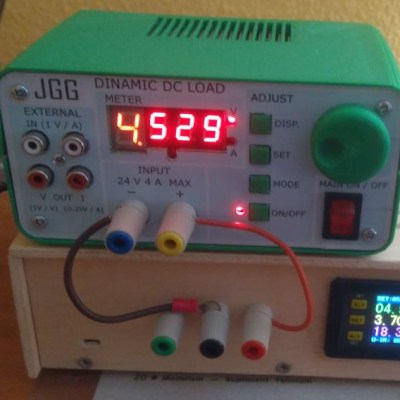Sometimes it’s necessary to make do with whatever parts one has on hand, but the results of squashing a square peg into a round hole are not always as elegant as [Juan Gg]’s programmable DC load with rotary encoder. [Juan] took a design for a programmable DC load and made it his own in quite a few different ways, including a slick 3D-printed enclosure and color faceplate.
 The first thing to catch one’s eye might be that leftmost seven-segment digit. There is a simple reason it doesn’t match its neighbors: [Juan] had to use what he had available, and that meant a mismatched digit. Fortunately, 3D printing one’s own enclosure meant it could be gracefully worked into the design, instead of getting a Dremel or utility knife involved. The next is a bit less obvious: the display lacked a decimal point in the second digit position, so an LED tucked in underneath does the job. Finally, the knob on the right could reasonably be thought to be a rotary encoder, but it’s actually connected to a small DC motor. By biasing the motor with a small DC voltage applied to one lead and reading the resulting voltage from the other, the knob’s speed and direction can be detected, doing a serviceable job as rotary encoder substitute.
The first thing to catch one’s eye might be that leftmost seven-segment digit. There is a simple reason it doesn’t match its neighbors: [Juan] had to use what he had available, and that meant a mismatched digit. Fortunately, 3D printing one’s own enclosure meant it could be gracefully worked into the design, instead of getting a Dremel or utility knife involved. The next is a bit less obvious: the display lacked a decimal point in the second digit position, so an LED tucked in underneath does the job. Finally, the knob on the right could reasonably be thought to be a rotary encoder, but it’s actually connected to a small DC motor. By biasing the motor with a small DC voltage applied to one lead and reading the resulting voltage from the other, the knob’s speed and direction can be detected, doing a serviceable job as rotary encoder substitute.
The project’s GitHub repository contains the Arduino code for [Juan]’s project, which has its roots in a design EEVblog detailed for an electronic load. For those of you who prefer your DIY rotary encoders to send discrete clicks and pulses instead of an analog voltage, a 3D printed wheel and two microswitches will do the job.















DC-motor! Yeah!
Easy infinite-turn pot/scroll-wheel from parts on-hand, and only one uC pin. Great hack. Definitely going in my toolbox.
“But can’t beat a proper encoder” (from his page) I beg to differ. This idea definitely has its places. A) obviously works in a pinch, B) Detents aren’t always desired, C) cheap encoders wear out, quality optical detentless encoders often have a lot of drag, or none D) great bearings/bushings, E) side-loads? F) analog=>resolution=>non-linear (software)… e.g. ignore anything below +-0.1V (pseudo-detent), scale quadratically from there G) some DC motors do have sorta ‘detents’. H) Panel-Mount screws, I) momentum/speed….
I also dig the LED-hacks, multi-purposing of uC pins, and there’s a function-generator input, for fancy load-testing.
J) can be converted into a motorised pot for that high-end audio system polish :D
Neat post and yes I also like the motor/pot approach as well as the potential for haptic feedback too eg as the heatsink starts to get too hot – I canny go further captn it’s gonna blow despite how much I push it…
All that and couldn’t spell “dynamic” correctly?
Enyweigh, anythyme wi can skrew up a shetty colonielist langwidge, y nawt du et?
All that awesome work and they couldn’t even spell “dynamic” properly.
Perhaps English is not his first language…I’ll give a little leeway for phonetic spelling ;)
LoL etc two post repeating banal objection – doh, tradenames perhaps whether approved or not or who cares, instead how about something useful, constructive etc qudos to the creator for making the effort, yah know other than facile criticism that goes “no where” – your gut has some 100 Millon neurons maybe they can help digest the significance of adding content to her brain so people actually want to search for, that enlivens debate, that offers lines of enquiries, that doesn’t show up low level of cognition consistent with IRC chat channels when drunk etc from mere annonymous simpleton nicks lacking credentials, capacity or even some provenance of intent or anything to advance tech or even the human conditon etc ;-)
IOW useful stuff for a change, ok dweeb :-o)
Maybe the ‘Y’ key on the keyboard was missing/broken?
That would match the spirit of this project ;-)
It seems odd to go through the trouble of printing such a nice case but not waiting to source a correctly-sized 7-segment display before final assembly, but I guess there’s something to be said for using up spare parts too! I like how the buttons are multiplexed with the display. Using a dc motor as a rotary encoder is brilliant; I wonder how much current does it put through the clamping diodes when it is spun quickly? It would be nice if the over-temperature shutdown were under analog control, so if the software locks up at least one of the safety features will still work.
Diggin’ it….
Dude with hi-fi motorize knob idea… that’s exactly what I was thinking for J! Great minds!
Then, haptic feedback… awesome. could be [software] detented after-all!
Now current and clamping-diodes… interesting. Am-thinking this makes for free-spin at low speeds and some sort of “braking” at higher speeds. That could be quite useful in a project, like the haptic-feedback idea. Different levels of clamping might, say, make a distinct sensation for adjusting a value by 1’s, 10’s, or 100’s.